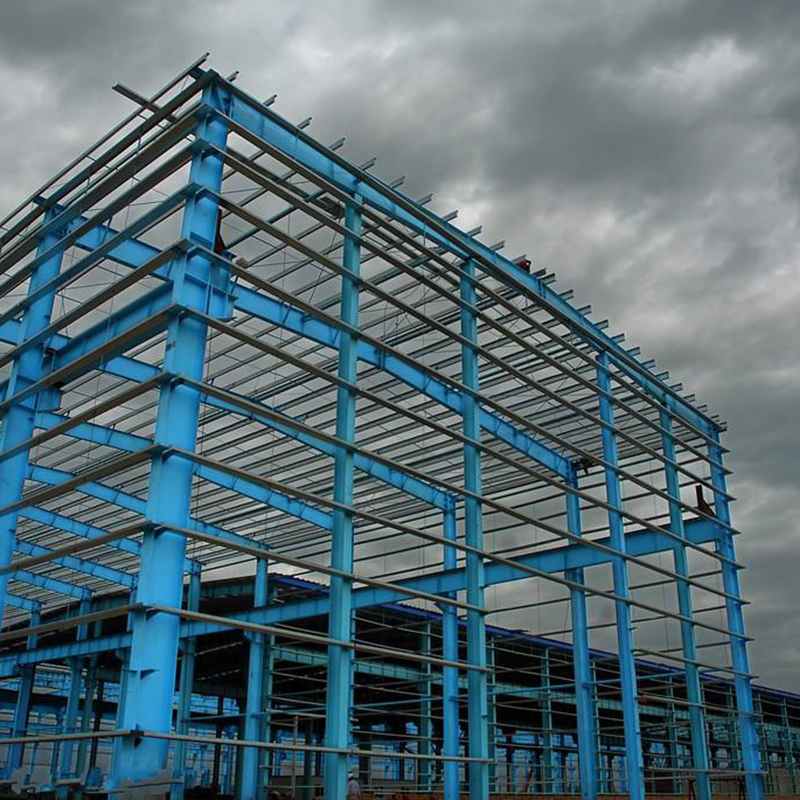Steel structure refers to the structural form which can bear and transmit load by connecting steel plate with hot-rolled, cold-formed or welded profiles through connectors.Steel structure system has the comprehensive advantages of light weight, factory manufacturing, fast installation, short construction period, good anti-seismic performance, fast investment recovery, and less environmental pollution. Compared with reinforced concrete structure, it has the unique advantages of “high, large and light” development. In the global scope, especially in developed countries and regions, steel structure is integrated in the field of construction engineeringIt is widely used.The steel structure industry is usually divided into five sub categories: light steel structure, high-rise steel structure, residential steel structure, space steel structure and bridge steel structure. At present, the business of the company mainly focuses on the first two categories.
Light steel structure mainly adopts light H-beam (welding or rolling;Variable cross-section or equal cross-section) is made into portal rigid frame, C-type and Z-type cold-formed thin-wall steel is used as purlin and wall beam, profiled steel plate or light sandwich plate is used as roof and wall enclosure structure, and low-rise and multi-storey prefabricated steel structure housing system is assembled with high-strength bolts, ordinary bolts, self tapping screws and other connectors and sealing materials.
The high-rise steel structure is mainly a structural system which is made of section steel, steel plate connection or welding into components and then connected.Steel frame structure, steel frame support structure and steel frame concrete core tube (shear wall) structure are often used in high-rise buildings. The latter is widely used in modern high-rise and super high-rise buildings. It belongs to the steel-concrete hybrid structure, which makes the steel and concrete complement each other and give full play to the material efficiency.
Shell steel – steel used to make shells.There are many kinds of shells, which are mainly used to kill the living forces of the enemy, destroy battle tanks, etc.Therefore, the steel for shell needs high strength and hardness. Under the action of explosion load, the fragment rate is high.Because cannonball is a consumable, it needs a large quantity and a low cost.Medium carbon steel or medium carbon alloy structural steel is generally used, such as 50Mn, 58SiMn and 60mnmo steel.
Gun steel — steel used to manufacture main structural parts of different types of cannon, such as body, tail and bolt.Cannons and howitzers are the main components.In the continuous shooting operation, the barrel is subjected to high chamber pressure and high temperature ablation, which requires the steel pipe to have high strength, high toughness and fire resistance.Medium carbon CrNiMo steels are usually used, such as pcrni1mo and PCrNi3Mo steels, with a proportional ultimate strength of 550-850mpa.Thin wall mortars are required to be light in weight. Generally, higher strength alloy steel is used, and the proportional ultimate strength of steel is required to be more than 1200Mpa.
Pellet — after the concentrate powder and limestone powder are evenly mixed, they are rolled or pressed into raw pellets with a diameter of 10-30mm, which are dried and calcined at high temperature to consolidate the particles.This kind of ore is called pellets.The pellet has uniform particle size, good permeability and reducibility.But the temperature control of pellet roasting is more strict than that of sintering.Pelletized ore also requires fine grain size of raw material and low moisture content of ore powder.There are two kinds of pellets: oxidized pellet and metallized pellet
Lightweight refractories – refractories with high porosity (40-85%), small bulk density (generally less than 1.3g/cm3) and low thermal conductivity (0.2 ~ 0.7W/m.k).Also known as thermal insulation refractory.It can be made into products with a certain shape or into bulk materials.There are many kinds of light refractories, mainly including clay, high aluminum, diatomite, hollow ball products and fiber products.Lightweight refractories are porous structures, so they have low strength and are not resistant to erosion and erosion. They are not suitable for load-bearing structures and parts in contact with solutions.It is mainly used for the heat insulation layer of industrial kilns.
Turbine blade steel blade is one of the most important parts of the turbine, which is responsible for transforming heat energy into mechanical energy.It works for a long time (> 100000 hours) under extremely complex working conditions.There are moving blades (installed on the rotor) and static blades (installed on the diaphragm).The short blades are only a few centimeters long, while the last stage blades of large steam turbines can be more than 100 centimeters long.Requirements for blade materials: when the working temperature is less than 400 ℃, the mechanical properties at room temperature and high temperature are required to be dominant; for some blades of high-pressure steam turbine working at 400 ℃ or above, the durability, plasticity, creep strength and creep brittleness are required to be dominant.In addition, fatigue and corrosion are also important indexes.Commonly used blade materials are: 20CrMo, 1Cr13, 2Cr13, 1crnmov, 1cr12wmov, 1Cr17Ni2, ni36w3ti, etc.
Spray metallurgy — in order to accelerate the physical and chemical reaction between liquid metal and materials, powder materials are sent to liquid metal by gas injection to complete the metallurgical reaction process, also known as spray metallurgy.The process is widely used in molten iron pretreatment and ladle refining to achieve the purpose of desulfurization, deoxidization, fine-tuning of composition and denaturation of inclusions.The reaction speed of this process is fast and the material utilization rate is high.
Post time: Jun-05-2020

